COLUMNS
ARTI-PHYSIS
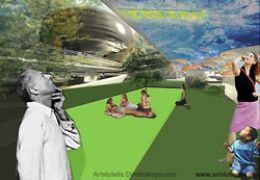
7 December, 2007
Gwangju Asian Cultural Center, Korea – International Competition Entry, October
Photonics Post-Virtuality: the building realizes virtuality in a pragmatic way. Through photonics, a utopian world of illusions comes alive; the bonds between reality and chimera become tighter. The project announces the uncanny world of obsessive communication through artificial intelligence, dissolves the barriers between the fictional and the natural suggesting a new status of existence. International Competition Entry for the Asian Cultural Center, Gwangju, Korea.
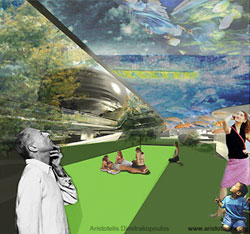
Project Data: this competition entry is the product of a 3-week charrette. Team leader was Aristotelis Dimitrakopoulos. The 5-person competition team worked incredibly hard to respond to the extreme programmatic requirements [160,000 m2 of cultural functions] and to demanding submission requirements [9 A1 boards along with booklets and text]. Architecture students Joe O’ Toole, Lucas Correa, Peter Glasson and Aungwara Nawacharoen worked passionately as members of the design team producing diverse ideas and incredible graphics.
Photonics Post-Virtuality: the building realizes virtuality in a pragmatic way. Through photonics, a utopian world of illusions comes alive; the bonds between reality and chimera become tighter. The project announces the uncanny world of obsessive communication through artificial intelligence, dissolves the barriers between the fictional and the natural suggesting a new status of existence.
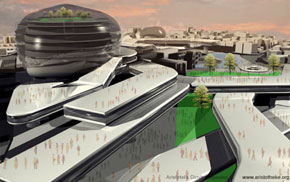
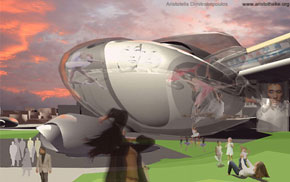
Inseparable Dualities: these realities are central to the development of the building and are demonstrated through collages that show how the building depends and relies on the operation of photonics. The physical existence of the building forms only one half of its identity, in terms of both organization and form. The building concludes its form in cyberspace, and cannot be conceived as a mere physical [formal] gesture. Its operation will depend at a great percentage upon non-physical interaction with remote virtual visitors. It is imperative therefore to visualize the virtual presence of the cultural center as integral to its conception. This intention is hard to present within the boundaries of a traditional architectural competition with hard copies and concrete deliverables.
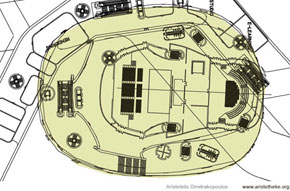
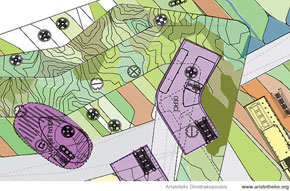
Inseparable dualities are integral to the existence of Korea and its political presence and agenda. This is integral to the design process. As a hint of how this translates in reality, consider that the proposed blob forms, liquid formations under fluctuation, have no real presence. The use of photonics cancels the presence of physical boundaries: the volumes disappear and the focus shifts into thematic reflections [projections or holograms] in constant flux. Even physical nonexistence can be perceived as central concern of this project, regardless if the galactic scale of the facility program and outset tend to overwhelm the designer with logistical questions.
For humanity, photonics is the ultimate answer to logistical concerns and this miraculous fact is reflected in the physical inception of this overwhelming programming exercise amidst the Gwangju city center. We are interested in the disappearing building rather than the monumental physical statement.
Jurassic Programming: the volumes and sizes of the programmatic outset refer to the Terra-scale: the project belongs to a scalar territory beyond bigness, where architecture simply evaporates under the pressure of immense service requirements, fire regulations, mechanical plants and “process” space [transitory areas]. The sheer massiveness of the program can be a factor diminishing human scale and all reference to any sense of context. Responding to the significance of the site history [the Democratization Movement] the development of experiential effects treating the whole site as a civic amenity was central concern, giving birth to the concept of an urban park that can be enjoyed even without reference to the enclosed functions, becoming a locus of urban identity.
Terra-Logistics: the bold and direct decisions dealing with concepts about building services become imperative in clarifying the project and allowing architectural experiences to occur. We provide a network of escape stairs, service elevators, mechanical shafts, smaller storage rooms that accommodate HVAC systems, sound, lighting, digital networks, linking the roof mechanical zones with all floors below.
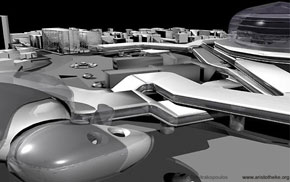
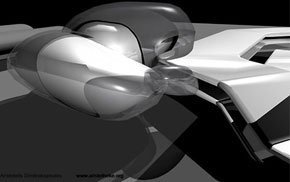
The clear decision was to create a visually repetitive element that could be set flexibly throughout the site not over-specifying the open spaces and allowing for different configurations. This service element would also need to act as the absolute structural support system of all decks and slabs on-site. This directive tackles the sensitive aspect of architectural projects that end up dealing with service facilitation salvaging and eating up entire sectors of building volume.
The desire to incorporate ever-changing cutting edge technologies and particularly developments in photonics is reflected in the erasure or celebration of logistics, in their incorporation into a living concept.
Cylinders - Services Concept: this line of thought led to the improvisation of the cylindrical shaft monad that is clearly identified throughout the project.
The cylinders are identical in diameter [7 meters wide and 0.5 meters thick concrete walls] and contain the full spectrum of building control systems ranging from service elevators, to escape stairs, to sheer storage space or to ordinary shafts.
Organizing Cylinders - Order vs. Lucidity: a generous repetitive rectangular mega-grid is imposed onto the site, underground, at –14 meters [below ground and over the subway tunnel] supporting all floorslabs and volumes above. The grid increment is 25x33 meters. The shafts are 7-meters in diameter. In section, whenever slabs are discontinued, the respective shafts are discontinued too.
In addition to this regular repetitive grid, another system of supports is inserted onto the exhibition level. This system responds to the positioning of the hovering strips above, serving as the system of support and service of these strips. Because of the irregularity of the planar configuration of the strips, the system of cylinders is therefore more randomized. The final density of cylindrical shafts in the lowest levels is the outcome of the coexistence of these two systems.
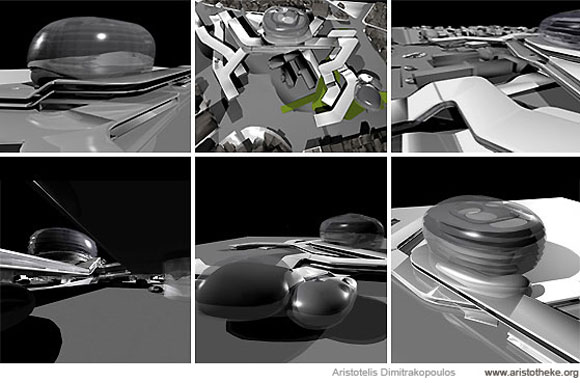
The interesting attribute is that the shafts that sit on the 25x33 meter grid are designed to serve the large exhibition spaces sufficiently. This translates into an interesting condition: the cylinders that come down from the elevated forms do not need to extend below the ground level all the services contained inside. As an example, the escape stairs of the above ground volumes are in different shafts than the escape stairs that move people from the exhibition levels to the ground surface. All escape stairs are terminated on the ground level. The cylinders go all the way to the foundation of the building. This means that these empty shafts can serve different purposes. The same applies for shafts containing service elevators.
However, the shafts that contain mechanical equipment or other building services in most cases need to continue all the way to the ground and remain functional.
Cylinders - Display Concept: the great attribute of these shafts is that they can serve as mini black boxes for media installations in case the services are not requiring the whole shaft width, or they can be perforated to allow cross views or even elevated catwalk connections running through them.
The external surfaces of the cylinders can operate as projection screens or media bands announcing or displaying information, or even providing interactive information about display elements. Developments in Photonics, fiber optics and holography would be exhibited there.
The internal space of the shafts is ideal for use as exhibition space for three-dimensional holograms that require reduced lighting conditions for display.
Double-Loaded Escape stairs: each of the elongated bullet-like shapes contains two stairs that share the same vertical shafts. These stairs are entered from opposite ends of the stair [each] and are stacked in a manner optimizing the void space in each of the shafts. This is a very important feature that manages to compress to half the total space devoted to escape stairs.
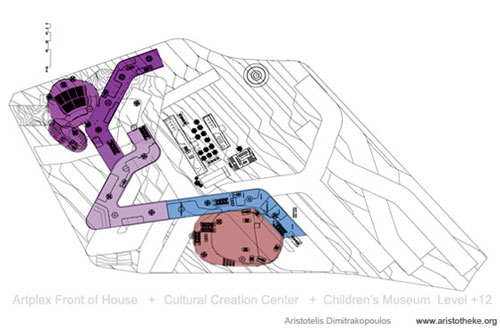
The density and randomness of the shafts in the large exhibition spaces might appear at first overwhelming to the viewer, however, it is a pragmatic assessment of the service areas needed, and escape stairs that respond to the levels of occupancy of the spaces. The cylinders are many, but the spans are great too. The visitor becomes part of an experientially strong environment: a sublime combination of imposing cylinders and bold singular cuts on the roof created by the ramps on the ground level.
Total Movement Concept: the tripartite movement concept considers movement on three levels: the ground level movement works in a radiant pattern, between and under the hovering volumes, connecting to various destinations surrounding the site.
The concept operates as a filtration system that transmits smoothly the visitors through various experiential processes. The Underground concourse level becomes a key element for the organization of movement between the various building complexes and to the subway station. The large concourse level is accessible through wide ramps that [at 4%] reach a major receded public urban space that funnels and regulates public circulation on-site. The concourse level operates radially, with public ramps alternating with access doors to the major public entries of the programmatic entities.
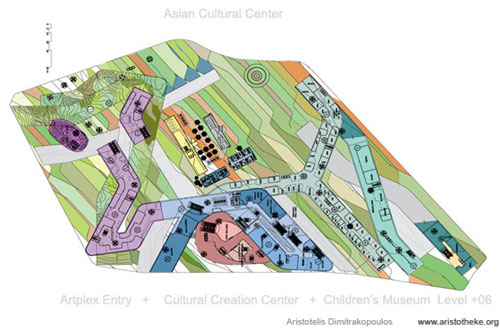
The third part of the movement concept focuses [as discussed] on the roof topographies. In this way, the buildings on site become unperceivable, merging with the landscape, giving the impression of a continuous park, an exploratory roof-scape terrain.
Underground Public Circulation: the subway station exit has been relocated and lies between the Fountain and the Provincial Center. The public is distributed through the sub-terrain of these main public spaces and ramps out towards various directions or uses the escalators and elevators that lead to the alternative public piazza generated in-between the preserved legendary buildings of the site.
Democratization Memorial: in reference to the memories of the democratization movement the opportunity offered is to rise up above the site and look down towards the axis of the events. The site has been largely left open to allow for personal contemplation.
Striating landscapes: as described in the city scale drawing, linearities emerge between the green zones around the site showcasing the promise of collective response to calls for greener living. Patches of landscape textures alternate based on the interweaving linear geometries and offer a loose mix of varied environmental conditions.
The piazza between the preserved buildings completely reverses the backyard status of the neglected parking zone that currently fronts the police administration facility. Cherry-tree lines create a representative Korean landscape that offers the incredible experience of cherry blossom.
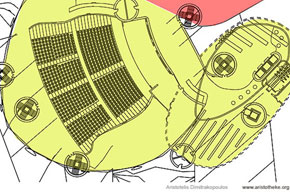
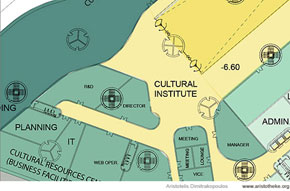
Jeonnam Provincial Center: the structure is hollowed and the back façade is totally removed. The slabs are removed and the whole volume is experienced as a single entity. Only escalators and glass cylinder elevators are contained in the structure, acting now as a surprising gateway that opens up unexpectedly towards the back piazza.
Police administration: this structure is handled similarly. The back wall is stripped away and the visitors’ facilities, lounges, info areas, etc are accommodated in an environment of sheer openness. These two giant portals [previously the Jeonnam Provincial Center and the Police administration] represent the crystalline portal under which democracy operates in Gwangju and in Korea at large, the way it extends to reach the world and promote the new agenda for Asia.
Expanding Giga Exhibitions: the huge singular exhibition plate at –12.80 meters clear height, is organized by a series of gridlines accentuated by the giant cylinders [as described earlier] and can be unified as a terra-universal space receiving light from above through the skewed cuts and bumps differentiating from the artificial ground surface.
Immediate Context Scales: the current state of the city introduces challenging parameters to the design process. The relative homogeneity of building sizes and densities around the site combines with a lack of public space and to the inadequately reduced presence of green.
The maze generated by almost randomly placed cuboids, where almost no sidewalks exist, with numerous precarious interventions inserted into the built fabric, appears as asking for an open, publicly-accessible series of spaces. In this sense, a mere composition of volumes would appear irrelevant to the ACC site, denying co-acting with the existing city. This aspect of the locality was highly accentuated in the design process and was not separated from the global and pan-asian mission of the project: the on-site physical presence of the cultural complex was valued as much as its virtual presence and its “design signature” profile.
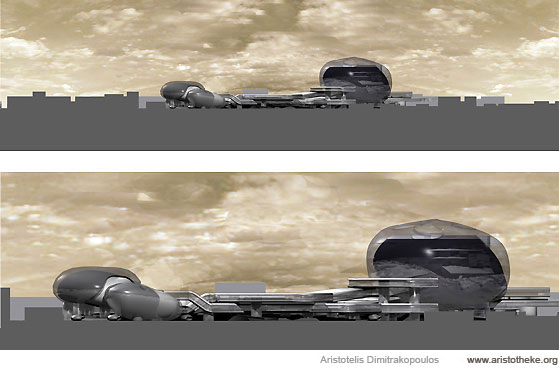
ACC Scales: referring to the small-scale average building sizes on site, a major concern that arises is the size of the programmatic entities of the new complex. The Jurassic scale of the singular exhibition volumes, the sheer circulation spaces and the voluptuous performing halls has posed serious concerns about the introduction of mammoth-sized objects in the city fabric. The necessity of such cultural entities typically requires clearly controlled accessibility patterns and endless expansions of external building surfaces characterized by overgrown building services.
Anti-Pompidou: analyzing the concerns about scale, an interesting case study is the much discussed Pompidou Center in Paris: At Beaubourg, a large singular volume, a giant parallelepiped, disproportionate to the existing context – almost dwarfing the immediate city fabric, manages to keep only one side clear from services and available to the city. In Pompidou, the huge footprint is absolutely inaccessible, a singular entry point is generated, it is almost like a large urban block that cannot be crossed by pedestrians. The only movement option is to walk along the perimeter, or to be sucked into the underground level entry hall of the building that acts as an ultimate dead end of circulation. While moving through the floorplates of Beaubourg, the experience is similar to a black box, with little or no experiential interaction with the city scape.
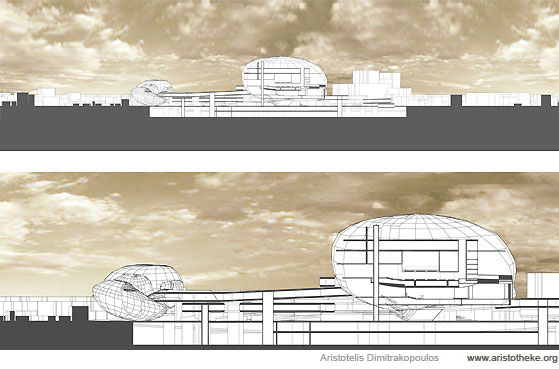
Shelled massing: the reaction to this range of issues was to detach the large volumes from the ground surface, and push them upwards or downwards, drastically but consciously. The effect is multifaceted. The large masses of exhibition space are buried below ground while the performing halls are treated as hovering blobs linked to the ground surface through structural service shafts and circulation shafts.
Stratifying Linearities: the smaller scale entities, the private areas for experts and amateurs, all educational spaces and administration functions inserted into linear strips. The landscape strips are developed as airborn sectional profiles sweeping segmented axes that fluctuate in height, addressing all x, y, z dimensions and running dynamically through the site.
Elevated topologies: the strips begin from the ground level, as strips flaking off the ground level and rising. Then they ramp up and down, switching directions and generating provocative experiential and formal interplays in-between.
Elevated contours: most roof areas remain walkable and accessible for all, using a basic ramping up slope of 4 to 5%. Then each of these surfaces becomes an elevated park for the citizens who can go higher up and enjoy sweeping views of the city and [above all] of the site of the Democratization movement. The specifics of this concept of movement are explained separately.
Roofing Poche Tectonics: the roofs are deformed to produce mounds that formulate an identifiable topography providing various sectional conditions for the experience of the outdoor roof spaces. Additionally, the advantages offered by the foldings on the roof plane relate to the ability to thicken the sectional poche’ and manage to fit larger vegetation and significant mechanical equipment that needs to have access to fresh air. The sectional foldings create slots of natural lighting that is cast through, signifying areas and axes within the underground exhibition spaces. In the cross section of a ceiling plate, the structural thickness of the slab is at times, at the edges, reduced to a minimum of 0.30 m thickness so that maximum amount of light is allowed into the underground areas [the shallow sloping of the ramps would otherwise admit insufficient amount of light to the interior spaces for the first 100m of the ramp].
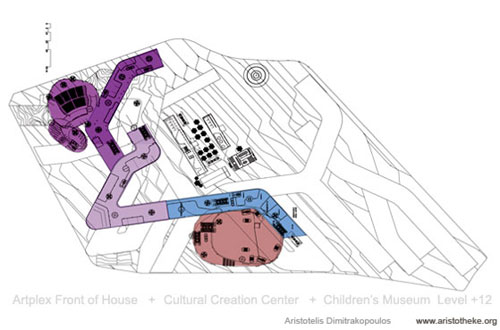
Attending Democracy: the concept for the Democratization Movement Memorial suggests taking people high above the ground level and orienting the views towards the legendary fountain; extending in this way the perspective of the Geumnam-Ro Boulevard. The idea of the elevated landscape strips derives largely from this idea, extending it downwards progressively towards the remaining sides of the intervention area. This perspective axis was the view of the civilians that participated in the tragic but glorious events. Specifically, starting from the south corner of the site, ramping planes rise, reaching a topmost zone that overlooks the square, and then start looping back and under themselves, enabling citizens to use this elevated route to reach the historic fountain, while simultaneously enjoying views of the Jeonnam Provincial Center, the Main Hall of the Police Administration and the respective Service Centers. From this ramp the visitors gain access to areas of the children’s museum spaces.
Merging and Superimposing: the elevated programmatic strips in many cases land upon each other enabling the creation of entry points. In other cases strips merge into one or split into two, enabling links and interconnections between programmatic areas or building complexes.
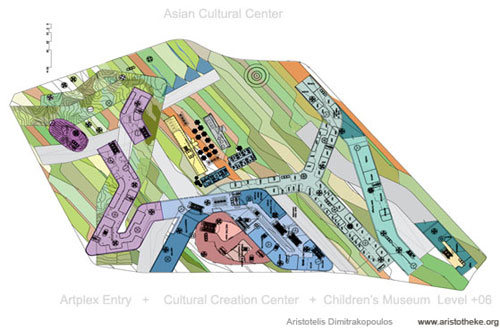
Construction - Strip Tectonics: the strips are typically 22 meters wide and 5 meters tall per floor [with 1 meter for ceiling thickness, 1 meter slab thickness, and 4 meters clear height – excluding the dropped ceiling and mechanical overhead or floor-level zones. The consistent cross section of these strips enables a systematization of the spatial experience, allowing constant interaction with the exterior and improving the sense of directionality throughout the interior landscape.

The slabs of the floor and ceiling of the strips are structural reinforced concrete waffle-slabs. The slabs are connected through structural elements, the 7-meter wide concrete cylinders, which connect all the way to the foundations of the building. The slabs are then cantilevered from these cylinders.
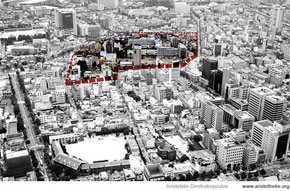
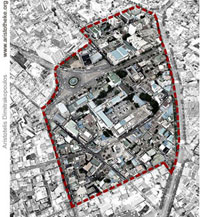
Issues of rigidity are resolved by use of a secondary structural system ensuring that the each set of consecutive slabs [roof and ceiling of each bar] are linked through vertical ferrous walls. This is achieved using the solid enclosure of all black box spaces contained in the strips as another type of lucidly defined vertical cylinders [terminated within the height of one strip]. The feature is presented in detail below.
Escalate: mechanized means of movement become imperative for the function of the very large complex and the sheer size of the program. Escalators are here used as a morphological element. The strips were studied as variant profiles positioned side by side, starting from the ground surface as ramps or jumping up aggressively, hovering and co-acting as continuous shells that orient themselves as open mouths of artificial caves towards the fountain paying tribute to the historic site.
The open ends of the strips examined the potential of rotating vertically and opening up towards the sky, creating slender flowing towers that could be used for the exhibition of photonic technologies, holograms and laser shows. This possibility was left to be studied at a second stage of development.
The future admittedly belongs to photonics. The virtual presence of holograms, self standing and self regulating, generates awe and uncanny feelings.
Interior Compartmentalization - Spatial Concept: the organizational focus of the individual programmatic bars deals with concepts of organizational clarity, increased awareness towards the spatial identity, and variety of configurations. The cylindrical shafts combine with more elongated –but still rounded- shapes containing the double-loaded escape stairs or triads of passenger elevators.
Restrooms, elevators, and shafts become typified and repetitive within the planar floor-scape of the elevated strips. These service elements are dispersed in a randomized but equalized manner [in terms of density] within the elongated floor-plates. The two already established typologies of the project are incorporated here too: the 7-meter cylindrical shafts and the elongated concrete capsules.

Interior Compartmentalization: Main Shapes + materiality: there are two types of enclosure for the programmatic entities in the strip-volumes: the more secular or private uses are encapsulated in solid rooms with curved [in plan] corners while the more public or casual spaces are enclosed in lighter, perhaps semi-translucent spaces.
Turtle Ships: researching the history of Korean design and construction, we were intrigued by the excellence and effectiveness of the Korean “turtle ships” and their organizational principles. The turtle ships stand out in the global history of inventions as an exceptional case of a military vessel. Their larger than usual volume, the iron-clad wood roofing and the ability to maneuver transforms the boat shell into a concave impenetrable “bullet”.
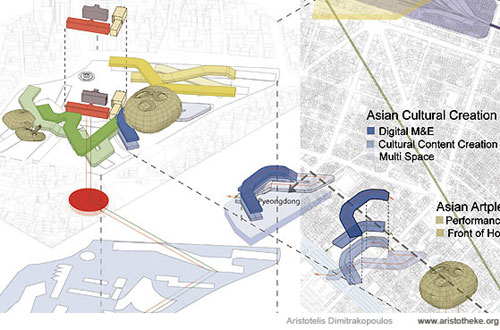
Turtle-scape: the alternative name for Mt. Mudung is “Turtle Mountain”. This was an additional element that reinforced our interest in the formal attributes of the turtle shell concept. This case the focus was on the formal aspects of the turtle shell, with bumps and mounds [the equivalent of the original scutes or shields] that generate a distinct but smooth topography. The potential of generating an accessible topography on the roof offers the possibility of accommodating large expansions of space and large volumes beneath, yet preserving a very open public experience at the upper and most perceivable layer, the roof.
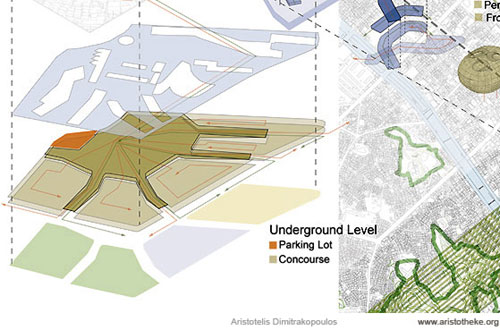
In this sense, the program could be inserted into the site, yet a publicly accessed landscape formulation would be the ultimate element perceivable by citizens and visitors, and a major statement/image towards the city. The smoothness of such a landscape would possibly give an illusion of reduced density in the ACC site. In this way, the Asian Cultural Center complex would not appear as an architectural agglomeration of shapes, but as a public amenity.
Introductory Conceptualization Text by Design Team Member Lucas Correa, Edited by Aristotelis Dimitrakopoulos, 2005.
Historically, the most powerful desire of the human race individualistically is accomplishment. The attainment of something that at first instance seems impossible but with enough effort and arduous work is achieved, is extraordinary. The gathering of large masses for an individual goal could almost be considered an oxymoron, a contradiction, but reality proves that as long as the goal itself is of heavy importance the scattered mass can actually condense into a greater individual object. This is the most meaningful condition happening in Gwangju at the present moment. After the notorious social and political crisis the city rises unified in various social branches. Art, technology, politics and the environment are the prioritized plan for the future of Gwangju. In honor of the past, the city intends to raise the quality of its citizens’ life.
Memorial or monumentality: The massacre and the uprising that occurred from the 17th of May to the 25th of May conditioned a popular unification at a grand scale. People of different social class and age gathered without prejudice for a unified cause. This can be directly adapted to architectural terms and conditions. A building can become a memorial without actually being classified as a memorial. The formal representation created from analogies can offer enough information for a viewer to understand the meaning conveyed. The complex, a direct representation of past events then becomes monumental, and simultaneously a direct metaphor for a memorial that in this case needs to come to existence. The building is the memorial. The fountain then can be left to exist in a pure form without any modifications as what it actually functions as, a fountain, and a gathering place for humans to discuss issues relative to their existence. The roundabout characteristic of the fountain is replaced by a 100 % green pedestrian accessed space enhancing its significance. The architect then leaves history alone to complete its tasks in reminding us the alternate significance of the fountain as being revolutionary.
Programmatic Strategies: The program itself being larger than the area given allows itself to be encapsulated in a monumental multistory complex. Sporadic design choices cannot be considered since there is not the enough square footage. Any type of urban spread goes also against the Asian city planning being itself very compressed. The high-rise and the underground are the ultimate strategies of spatial compression and need to be considered fully for the design. The design would be the epitome of the condensed city. In a populist sense, the high-rise is also the ultimate monument for collective consciousness and program.
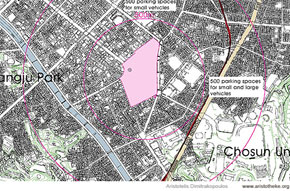
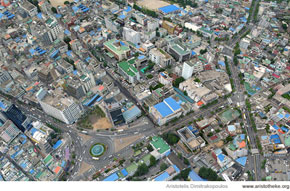
Photonic Technology: The name of the city of Gwangju in South Korea literally means 'City of Light’. Photonics play a major part in the development of the different stages of the design for the complex. This is represented from the main connection of spaces to the design details. Incorporating fiber optics and laser technology as means to design rich interactive elements within the building is a central conceptual directive. Fiber optics can be multi functional, transferring video images from one point of the site to another or carrying light and sound within the site or building. This imports the thought of a total “light and sound membrane”. It will also accentuate the city’s proposal for enhancing and investing in future photonic technology.
Photonic Conceptualization: The unification or gravitation pull of the unit or the fragmentation into a larger form works the same way at every scale of reality. The sub atomic level composed of particles like the photon, works in exact patterns to which large scale objects conform. The gravitational pull of people work the same way as the gravitational pull of stars, the same principles apply in every scale of nature. Low entropy always tends towards high entropy. Theory of relativity and Quantum mechanics once having direct mathematical argument with each other are unified for once with superstring theory.
This marks a breakthrough in the understanding of the cosmos. The standard element of study in the sub atomic level for the behavior of nature is the photon. It is also the main study element that Gwangju wants to focus on for the long term future. Its importance goes beyond mere fiber optics it actually can explain the significance of life. The composition of the building can vary from a single whole to different wholes, gravitational pull can happen at different points on the site.
The same way as connectedness and circulation needs to be direct and inter-related at different scales. The common tower looses that characteristic by being linear. The design needs to overlap in many points. Circulation needs to branch out and loop around. The imperative idea that needs to be considered is wholeness and high entropy causing program and space configuration to be more open and flexible. As in quantum mechanics, the photons are connected with each other no matter their position in space and sometime time. The calculation or manipulation of one photon will directly affect another one. In this sense each space or program could directly affects the rest.
Aristotelis Dimitrakopoulos, 2005.
Related articles:
- HORROR VACUI: JOSTLE, HUDDLE AND HELLENIC MODERNITY ( 21 June, 2005 )
- ATTIC ECTOPIA ( 16 November, 2012 )
- FRONTAGE SHOWCASES AND THE POST-URBAN UNCANNY-A RECTROACTIVE MANIFESTO FOR HELLENIC PROFESSIONAL SPACES ( 01 January, 2010 )
- VI: Unrecycling Cyclades. Part 1 ( 04 October, 2010 )
- De-institutionalizing Education: Notes on Academic Initiatives(i) ( 7 July, 2007 )
- HARBORING CAR-BAN-ITIES [Port Nord Organizational Protocols] ( 8 October, 2007 )
- Stratifying Axialities> Celadina ReCelled (PART A) ( 14 March, 2008 )
- Stratifying Axialities> Celadina ReCelled (PART B) ( 11 April, 2008 )
- FRAGMENTARY IMPUNITIES > VALLADOLID TRAJECTORIES (PART A') ( 5 September, 2008 )
- FRAGMENTARY IMPUNITIES > VALLADOLID TRAJECTORIES (PART B') ( 5 November, 2008 )
- SUBTERRA * SUPRATERRA ( 22 May, 2009 )
- VI: Unrecycling Cyclades. Part 2 ( 14 October, 2010 )
- Translocality as a Post-Native Narrative ( 16 February, 2011 )
- Metaxekisis : Re-Thinking the Athenian Court ( 08 December, 2010 )
- L-I*-THEKE ( 02 April, 2013 )
- House - glyptotheque - gallery - workshop ( 19 July, 2013 )
- Piloting Pilotis ( 31 December, 2013 )
- Escalteca of the Choetheque Series ( 01 April, 2014 )
- Schottheke of the Choetheque Series ( 01 June, 2014 )
- Floatheca Rh of the Choetheque Series ( 01 August, 2014 )
- Floatheca Sp of the Choetheque Series ( 26 September, 2014 )
- O-theke of the Choetheque Series ( 11 March, 2015 )
- Floatheca Cy of the Choetheque Series ( 03 January, 2015 )
- Ophthalteca ( 24 June, 2015 )
- Y-theca of the Choetheque Series ( 08 October, 2015 )










